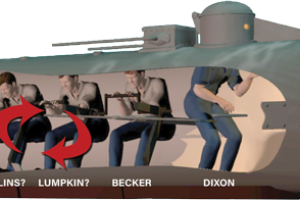(July 12, 2003 – CHARLESTON, SC) The Hunley project is beginning what may prove to be its longest and most challenging mission yet: the actual conservation of the submarine. In a first step toward the conservation phase of the Hunley project, scientists removed a quarter panel of a hull plate, located in the forward ballast tank on the port side. This is the fifth hull plate to be removed from the submarine.
During the removal of the plate, the team noticed a 6-inch crack in the upper section of the panel. “The panel was x-rayed and you can clearly see the crack. At this time we believe it appears to be an old attempt at repairing the plate, but we don’t know when the repair occurred,” said Maria Jacobsen, Senior Archaeologist.
The plate removal is critical for both the conservation and excavation efforts to continue. Removing the plate will aid Hunley conservators in collecting iron corrosion samples from the panel itself and on the “seams,” where the hull plates meet. The samples will be analyzed and processed for their chloride content. Once the varying levels of chloride infiltration are determined for the hull, scientific staff will begin to research and map out a conservation plan for the Hunley. The Hunley represents a unique conservation challenge as an iron artifact of the submarine’s size and complexity has never been fully conserved. Paul Mardikian, Senior Conservator on the Hunley project, said “Only science can carry the marine artifact conservation discipline into the 21st century.”
The conservation research is taking place in collaboration and through a partnership with Clemson University. Clemson professor Dr. Michael Drews said, “The corrosion studies we are conducting on the submarine could have ripple effects that extend far pass the confines of the Hunley conservation project.”
Clemson and Hunley researchers say that they are optimistic that applications of their research will benefit industries that deal with the challenges of metal corrosion, such as the treatment of metal for bridges, ships, oil drilling platforms and the metal infrastructure in some types of chemical plants.
The removal of the fifth hull plate will also support on-going excavation efforts. The forward and aft ballast tanks of the Hunley have yet to be excavated. Archaeologists needed the plate to be removed to gain access to excavate the forward ballast tank. The removal of the plate allowed Hunley staff to see that the forward ballast tank is also completely filled with silt.
The H. L. Hunley was located in 1995 by Clive Cussler’s National Underwater Agency (NUMA), a 501c3 non-profit organization. The hand-cranked submarine was raised in 2000 and delivered to the Warren Lasch Conservation Center, where an international team of scientists are at work excavating and conserving the historic vessel and its artifacts.
Hours of operation for public tours and the Hunley gift shop are from 10:00 a.m. to 5:00 p. m. on Saturdays and from noon to 5:00 p. m. on Sundays. All proceeds go to support the Hunley conservation and excavation project. To purchase tickets call toll free 1-877-4HUNLEY (1-877-448-6539) or log onto the Internet at www.etix.com.



